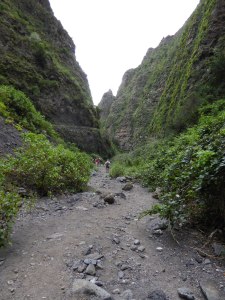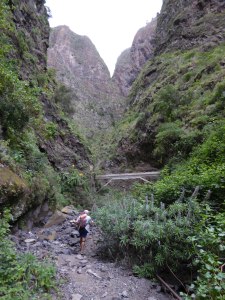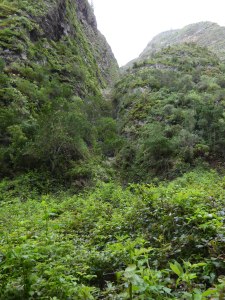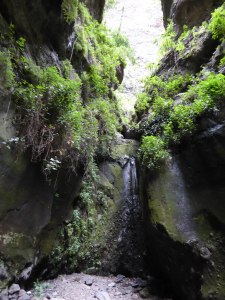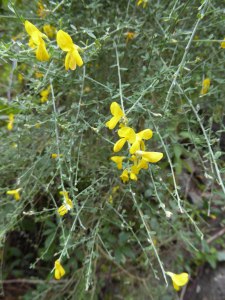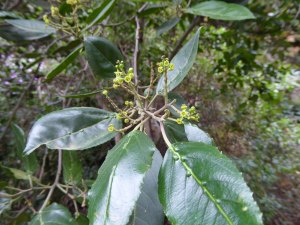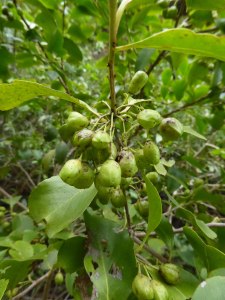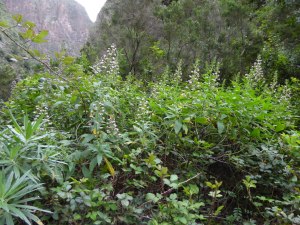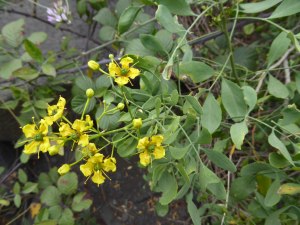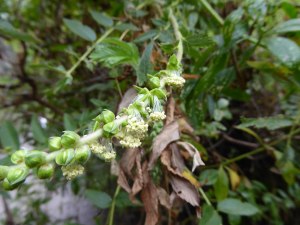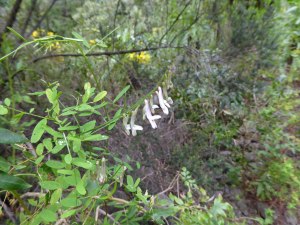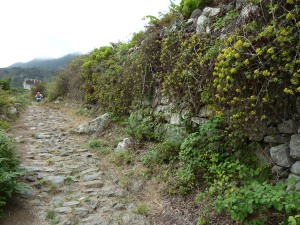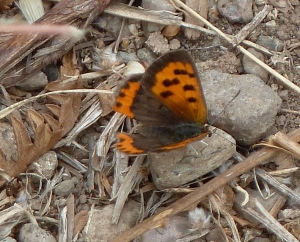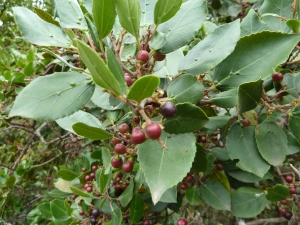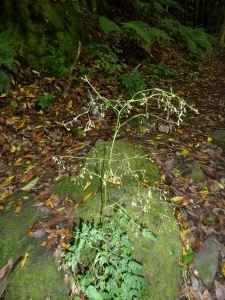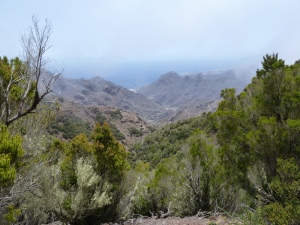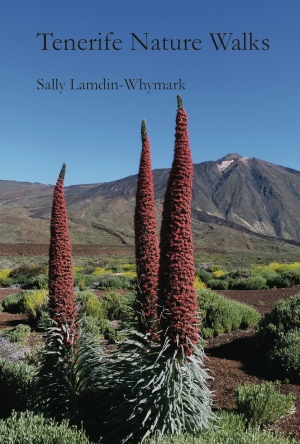Blog Archives
North to South in the Anaga peninsula
Last Friday a friend and I did a great walk from Taganana in the North of Anaga to the village of Maria Jimenez on the south coast near Santa Cruz. It was a scenic and varied walk, with parts through farmland, laurel forest and dry south-facing zone. We were lucky with the weather, despite some cloud near the summit when we were in the forest zone, we were able to enjoy the views of the rugged landscape the rest of the way.
We reached Taganana on the bus no 946 and started out on PR-TF 8 which starts near the church, and is signposted and waymarked with yellow/white livery. This path is also called Las Vueltas de Taganana. You follow the road round the barranco and just after passing a Pharmacy on the right, look for the turning left up a steep cobbled street. At the top of that street follow the signs round to the left in front of some houses and then on upwards, becoming a path, although still well-cobbled. The walls at the side of the path were well hung with plants of Aeonium lindleyii with its yellow flowers.
As we climbed away from Taganana, I saw in the path some Scabious (Scabiosa atropurpurea) plants I had never before seen in Tenerife. Apparently they are probably an introduced species and only found in certain localities. Around the same area I also caught sight of a Small Copper butterfly (Lycaena phlaeas). Although the book I have about Canarian butterflies says this butterfly flies all the year round, I have only ever seen it in the summer myself.
Higher up the fields either side of the path started giving way to shrubs such as Tree Heaths (Erica arborea) and various evergreen laurel-type species such as Faya (Myrica faya) and Sanguino (Rhamnus glandulosa). The latter is of the buckthorn family and one specimen beside the path was full of berries. You can see in the picture the lumps on the leaves (glands) which give it its latin name.
In this open shrubby area I also saw 3 Cleopatra butterflies (Gonepteryx cleobule), a bright yellow species similar to and related to the Brimstone (Gonepteryx rhamni) butterflies in Britain. Interestingly, both species feed on buckthorn species as caterpillars, which may explain why I saw the Cleopatras in that area. Unfortunately I was unable to get a picture of any of the 3 as they were too busy chasing each other!
Soon afterwards the path plunged into the deeply shaded thick laurel forest. It was damp in the forest, and higher up the path became quite slippery so we were glad we were climbing rather than descending. However, due to the dampness there were lots of plants to see including the majority of the flowers I saw that day. These included Canary Islands Buttercup (Ranunculus cortusifolius), although they were nearly over, Laurel forest Parsley (Cryptotaenia elegans), a delicate umbellifera a bit like Cow Parsley, Reina del Monte (Ixanthus viscosus), Large-leaved St John’s Wort (Hypericum grandifolium) and Milky Cineraria (Pericallis appendiculata). All of these species are typical of the laurel forest and are all Canary endemics, except for the Buttercup, which, despite its name, is a Macronesian endemic as it is found on some other Atlantic islands.

Part of the path through the laurel forest with Woodwardia radicans ferns on the left. The dark lump on the tree trunk further up is Laurobasidium lauri.
In the laurel forest I also noted four different types of fern, including the magnificent and huge Woodwardia radicans which, in places, covers the banks of the path with its giant drooping fronds.
Low down in the laurel forest there were some trees with huge laurel-like leaves, much bigger than any of the other species seen in the forest. I believe them to be Delfino (Pleiomeris canariensis), which is one of the less common trees of the laurel forest. However I am reluctant to definitely identify them as Delfino until I have seen them in flower or fruit to confirm the identification. I was pleased also to see a fine specimen of the fungus Laurobasidium lauri which grows only on Canary Laurel (Laurus novocanariensis) trees.
Still in the laurel forest, and after about 2 hours of walking, we reached a signpost with two alternative routes, and we turned left. We were now on the ridge running the length of the Anaga peninsula. After a little more climbing we took a right fork in the path and began to gently descend, still beneath Tree Heaths, so we could not get our bearings well. When the path began to descend more steeply, the shrubs diminished in height and we finally had a view down to the south coast, and Santa Cruz. Even further down we suddenly came upon a break in the bushes which gave us a view along the valley we were descending into, the Valle Brosque. The path descended rapidly, zig-zagging to make it bearable. There was a strong wind blowing on this stretch of the walk and we had to take care we did not lose our balance with the gusts on bends.
Beside the path as we descended were areas between the shrubs covered in Houseleeks which I believe were Aeonium canariense, though the flowers were distorted possibly by the drought. They weregrowing with Shrubby Plantain (Plantago arborescens) and Tomillo (Micromeria). The shrubby cover included Tejo (Erica scoparia ssp platycodon) as well as the Tree Heath. This is another heather species which grows tall like a tree, but not as tall as the Tree Heath. Further down the shrubs belonged to the xerophytic zone, dry-tolerant species such as Bitter Spurge (Euphorbia lamarckii), Canary Spurge (Euphorbia canariensis), Mosquera (Globularia salicina), Incienso (Artemesia canariensis) and Prickly Pears (Opuntia spp). There were also a number of trees with leathery evergreen pinnate leaves which I was curious about, that turned out to be Carob Trees (Ceratonia siliqua), planted to provide fodder for animals.
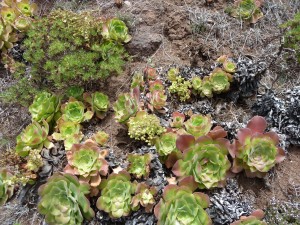
Houseleeks (prob. Aeonium canariense) with shrubby plantain (Plantago arborescens) on the descent to Valle Brosque
The path was coming down to a group of houses when we reached a signpost indicating another path to the right going up to the ridge, or an alternative to the left stating there was a bus-stop 60m away. We went that way, but were not hopeful about the bus. At 60m, or there about, we reached tarmac. Seeing no information about bus times, we decided to carry on walking down the valley towards the coast road where we knew there were buses every 10 mins at that time of day. However, the walk on the road was about 4.5 km and took us an hour to walk down. Half-way down we met a small bus coming up – the 916. We thought if it passed us again on the way down we would hail it. However it did not overtake us till we were nearly at the coast road and had taken a pedestrian street, so missed it. However, we did not wait long at the bus-stop on the main road.
The walk was a total of 14.9km / 9.3ml, and involved around 880m/2900ft of climbing. It took us 4hrs 50m. If you looked up the times of the 916 bus before you went you could shorten this by 4.5km and 1hr.
